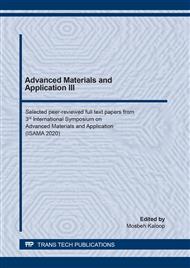p.23
p.29
p.34
p.41
p.47
p.52
p.59
p.65
p.71
Effect of Synthesis Conditions on the Preparation of Ag/ZnTiO3 via Sol-Gel Method and its Antibacterial Properties
Abstract:
Antibacterial materials based on nanotechnology have been attracted considerable attention by the scientific community. In this study, the sol-gel method was applied to prepare of antibacterial materials from tetra-n-butyl orthotitanate, zinc nitrate and ethylenediamine tetraacetic acid (EDTA) as a complexing agent. The effects of the synthesis conditions on the properties of the Ag/ZnTiO3 samples such as the calcination temperature, the calcination time, pH value and ethylene glycol volume, were investigated. The obtained materials were characterized by powder X-ray diffraction (XRD) and their antibacterial activity against Staphylococcus aureus (S. Aureus) was evaluated. The results showed that the optimum conditions for Ag/ZnTiO3 synthesis were: calcination temperature of 650°C, calcination time of 2 h, pH value of 4.5 and ethylene glycol volume of 4.5 mL.
Info:
Periodical:
Pages:
47-51
Citation:
Online since:
August 2020
Authors:
Keywords:
Price:
Сopyright:
© 2020 Trans Tech Publications Ltd. All Rights Reserved
Share:
Citation:


